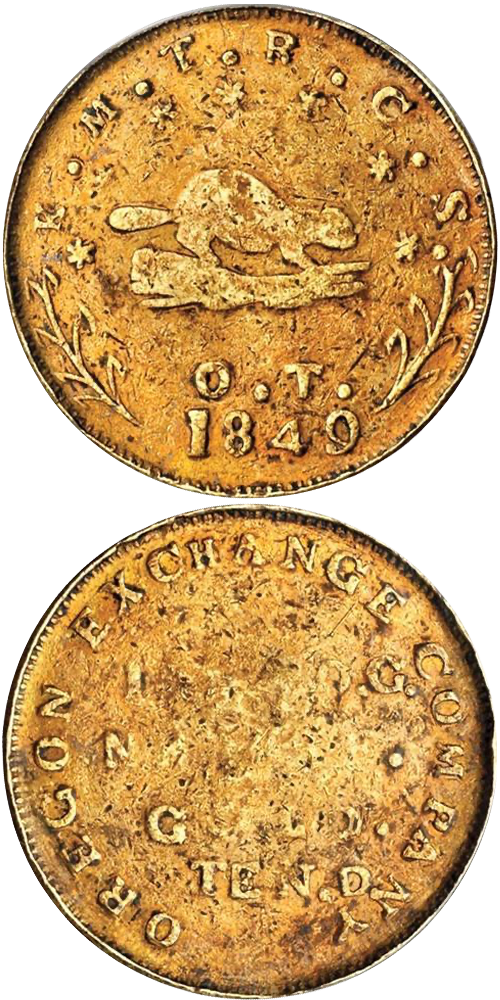1849 Oregon Exchange $10.00
The Coins of the Oregon Exchange Company, and Oregon's Other "Money" Attracted by the exciting news from California, many settlers in the Oregon Territory headed south to the gold fields where they spent the summer and autumn of 1848. At the time no minting or assaying facilities were in operation there, so they had no choice but to return to Oregon with gold dust and nuggets. In February 1849, petitions were submitted to the Legislature of the territory, seeking the establishment of a mint. On February 15, an appropriate act was passed, but on March 3 it was vetoed by Governor Joseph Lane, who felt that this would be in violation of Federal laws. As round trip mail to Washington, D.C., took two months or so at the time, there was no way to secure a ruling. To remedy the situation in a practical way, eight partners formed the Oregon Exchange Company, in Oregon City, and established a private mint. The last initials of the partners were used on the obverse of the coins produced, their names being W.K. Kilborne, Theophilus Magruder, James Taylor, George Abernathy, W.H. Willson, William H. Rector, J.G. Campbell, and Noyes Smith. It is believed that about 6,000 of the $5 coins were made and 2,850 of the $10 value. These were used extensively in local commerce. In time, nearly all were melted, leading to the rare characteristic of these pieces earlier mentioned.
Struck with California gold dust beginning in the spring of 1849, the coins of the Oregon Exchange Company were among the most intrinsically valuable of all private coins of this period, with metallic content worth some 10% over their stated value (i.e. their melt value was roughly $11). Their rarity today is undoubtedly a function of the profit to be made by melting them. Though 2,850 specimens of this denomination are said to have been struck—less than half the number of the rare 1849 Oregon $5 coins produced—today fewer than 20 are known, a few of which are impounded in collections such as that of the Smithsonian Institution. PCGS has graded a specimen on only seven occasions, only two of which were graded higher than EF and none of which merited a Mint State assignment. The Garrett coin had a planchet flaw and, though graded VF-20 in that sale, did not have as much obverse detail as this piece; it still brought $40,000 in 1980. The Zabriskie sale of 1909, one of the greatest offerings of territorial coins ever, included one that was mounted and holed. A net-graded VF-20 coin, cleaned and showing a large planchet defect, was sold in the 2000 ANA sale for $50,600. The beautiful EF-40 (PCGS) Klausen piece, sold by Heritage in 2002 and to date the only specimen sold by that firm, realized $126,500. The only other offerings listed by Dannreuther-Garrett since 1993 were for the same piece, a gilt tin specimen offered twice by Stack's. For a pioneer type collector, there are few issues more challenging to locate and acquire than the Oregon $10.
The example to the left was sold by Stack's Bowers Galleries in the Old West & Franklinton Collections, where it realized $138,000.






